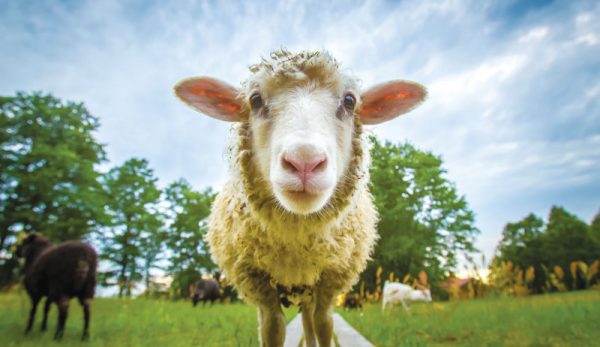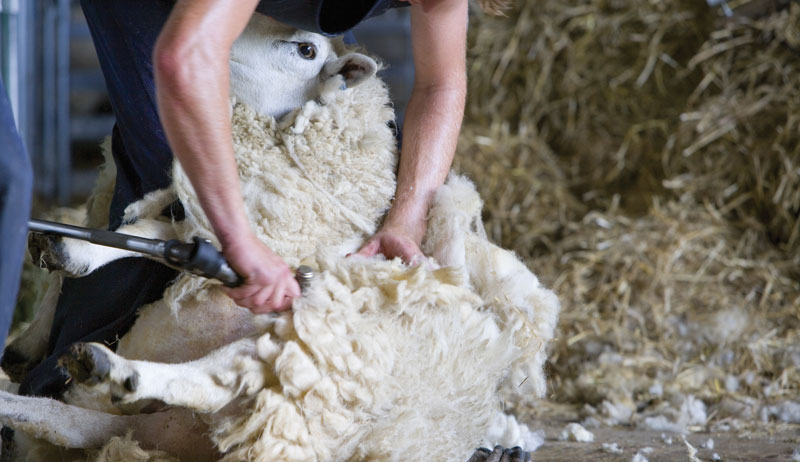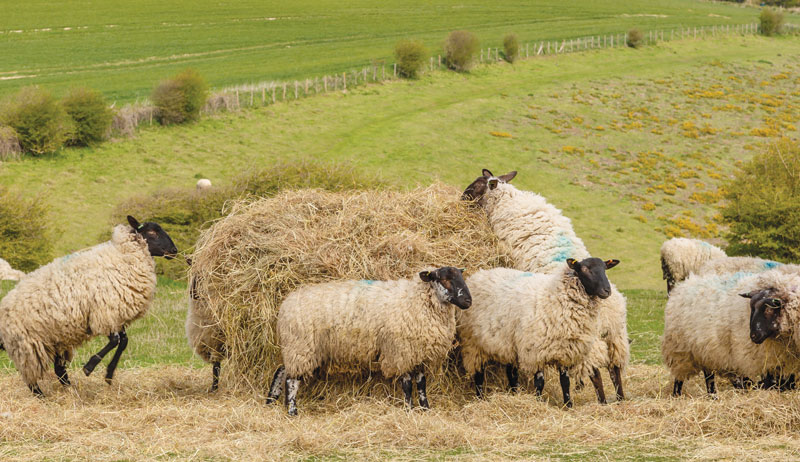
Sheep are a fantastic option for small-farm livestock. They are easy to manage without special equipment, and they are effective foragers in small areas. Sheep can serve a variety of purposes, and a wide variety of breed options means a good fit exists for every farm.
More Than Wool
Sheep are commonly used for wool, but they are also a great source of meat and milk.
Different breeds of sheep yield varying qualities and quantities of wool. All sheep need to be shorn, but the value of the fiber depends on the breed of sheep and wool quality. So keeping fleece in mind when choosing a breed is important.
Selling the fleeces from your flock is a great way to earn some extra income even if wool isn’t the main goal for your flock.
A great source of protein, sheep efficiently convert feed into meat and can utilize land and feed that other livestock can’t. While sheep do an exceptional job of foraging browse, with some increased nutrition they muscle up quickly and can finish in less than a year.
Cooking with lamb is very similar to cooking with beef, something that most people are comfortable with. And it tastes great.
Utilizing older sheep for meat is not ideal because the mutton can be pungent and tough. Additionally, processing animals close to breeding season increases the likelihood that the taste will be gamey.
However, lamb raised to be used as food rarely tastes gamey and is tender, not tough, with a moderate fat content. 
Sheep for Dairy
Another purpose small-farm purpose sheep can serve could be milk.
Dairy sheep are great milk producers but won’t give you an overabundance of milk like a cow would. Many sheep breeds produce enough milk to provide for their offspring as well as your needs.
In addition to using the milk and cream, you can make sheep cheese, a wonderful product in high demand in niche markets.
Land Management
Sheep are also great at managing small-farm weeds or clearing brush in overgrown areas. Because they are small and effective foragers, they can quickly bring unmanaged land back into a workable state.
Land management and reclamation can be a great small-farm use for your sheep.
Sheep are also very good at reducing the fire potential of land when proper grazing management is used. They eat the fire fuel, making the areas where they graze less likely to burn in the event of a wildfire.
In fact, some cities are considering having sheep graze portions of land that needs regular management as an alternative to having human staff do it. If you need extra space for your flock, land management and reclamation could be a great option to explore.
Learn how animals can heal the land through regenerative agriculture.
Housing
Because they are so effective at grazing, sheep don’t need a huge property to live on. Even if your acreage is small, sheep can still graze and forage.
Organizing your property into a rotational grazing system gives you the best use of your property. Rotational grazing also allows the sheep to evenly utilize the land and is a great way to manage parasites.
As long as the sheep have adequate shelter, so they have an area to get out of the weather, they are content.
The best kind of shelter for sheep is a deep shade shelter, which keeps the ground cool throughout the day during the summer. Sheep can very effectively deal with cold weather but less so with heat. So adequate deep shade is necessary for their health and comfort.
Fencing
Proper fencing is vital for keeping sheep safe. Not only does this make sure they stay out of trouble, it’s also important for keeping predators away.
Sheep, and especially lambs, can be easy prey for a wide variety of predators including dogs, coyotes and even large birds of prey.
Small grid wire fencing effectively keeps sheep in and predators out.
Electric fencing is also becoming more popular. It’s available in a strand that is run on poles like traditional fencing, as well as in a grid.
If you use the electric grid fencing, be sure the voltage is high enough to discourage any kind of interaction with the fence. It can be dangerous if an animal gets tangled in it. This is especially true if the sheep are horned.
Pens
Pens are very useful when it comes to keeping sheep. If you plan to breed your sheep, you need multiple areas to keep them so you can separate your rams from your ewes until you want them bred.
This could be separate pasture areas or pen areas. Having a space to separate your sheep is also helpful for routine health care such as shearing, vaccinations and hoof trimming. It’s much easier to catch sheep in a small area.
Pens are also necessary for lambing. Ewes can lamb on pasture without problems, but if a problem does arise, it’s easier to have your ewe close by so you can assist.
It is also helpful to have small pens for lambing in case ewe-lamb bonding is an issue. A small pen can help the ewe and lamb bond, alleviating you from having to bottle feed.
Pens are best set up with no possible way for the sheep to escape. When pressured, sheep can squeeze through very small spaces or even jump higher than you would imagine. Lining traditional livestock panels with a small grid panel or building wooden panel walls is a good way to keep sheep secure.
Nutrition
As with any livestock animal, proper nutrition is important for keeping your sheep flock healthy and productive. Most sheep need minimal supplementation, but it can be necessary.
Sheep should always be offered free choice sheep-specific mineral. This can be in a tub or block or a loose powder.
Sheep mineral is different from other livestock mineral and should not be substituted. Sheep are very sensitive to copper and can easily get copper toxicity. Copper toxicity in sheep is typically fatal. Sheep mineral and feeds should be free from copper.
If you purchase anything labeled “general use” for livestock, check the guaranteed analysis tag to ensure it contains no copper.
In addition to a sheep-specific mineral, sheep need an adequate forage source. This could be dried grass hay, pasture or rangeland. Sheep do a great job of utilizing very basic and even poor-quality feed sources, but check the body condition of your sheep regularly to gauge whether you need to adjust nutrition.
During breeding and lambing, sheep might need additional feed supplementation. Depending on your sheep, this could mean improving the quality of hay from grass to alfalfa or offering an additional energy source such as grain.
A high-quality, high-energy feed contains a lot of protein and has additional fat. Many of the sheep-specific formulated feeds available are great options when supplementation is necessary.
Learn how to determine the body condition score of your sheep.
In Good Health
Before lambing, sheep shouldn’t be overconditioned. Overconditioned ewes are more likely to have metabolic health problems after lambing than ewes that are average condition.
Once the ewe has lambed, closely monitor her body condition because milk production can take a quick toll on her.
If you grow out lambs for meat, you might also want to supplement them with some kind of grain. Muscle is built most effectively with high-energy feeds.
Feeding grain can also influence the flavor of the meat. Grass-fed sheep (and cattle) can taste slightly more gamey than grain-fed animals. Feeding grain can also influence marbling and tenderness of the meat. Lambs supplemented with grain tend to have better marbling and tenderness.
It’s extremely important to make any diet changes very gradually, regardless of why you make them. Sudden diet changes can cause your sheep to bloat, which can be fatal.
Make feed changes over a few days or weeks—depending on the magnitude of the change—and monitor body condition as you change feed. It’s especially important to monitor body condition before and after lambing.
Sheep truly are a remarkable small-farm ruminant. They are easy to manage without equipment and do a fantastic job of utilizing small areas effectively.
They are typically low-maintenance when it comes to feeding and can produce meat, wool and milk. Sheep even make it easy to earn extra small-farm income.
Just beware: Sheep are so great that you might end up with a larger flock than you intended. Once you get a few, it’s difficult to keep from adding more.
Sidebar: Meat vs. Wool vs. Dairy Sheep
- Meat sheep are breeds that grow quickly and have great carcass qualities. These breeds don’t usually produce exceptional fleeces. Common meat sheep breeds are Suffolk, Babydoll, Hampshire and Dorset.
- Wool sheep give high-quality fleece reliably. The quality of the fleece is determined by the micron diameter of the fiber, the lanolin percentage and the staple length. Common wool breeds are Merino, Rambouillet and American Cormo. Rare breeds include Harlequins.
- Dairy sheep breeds include East Friesian, Lacaune and Awassi. You might have a certain ewe of another breed that is a great milk producer. Often these more common breeds are used for milk production when a particularly productive ewe is discovered.
This article originally appeared in the July/August 2019 issue of Hobby Farms magazine.




